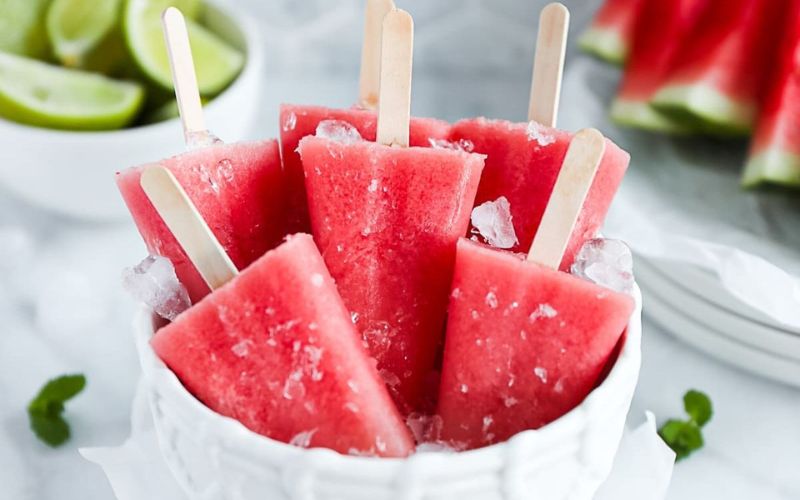There’s no greater pleasure than sinking your teeth into a luscious, ripe summer watermelon on a scorching hot day. When your taste buds are greeted by an incredible sweetness and juiciness, you know you’ve found the epitome of perfection.
The vibrant colors and refreshing texture enhance the overall experience, making it a beloved fruit for many. However, as passionate watermelon enthusiasts, we have all had our fair share of disappointments when encountering a lackluster slice devoid of flavor and with an unfortunate starchy consistency. It’s a sad moment that can leave us feeling utterly let down.
But fear not. For this season, we share some invaluable storage tips to ensure your watermelon stays fresh and delicious for as long as possible. By following our expert advice, you can bid farewell to those lackluster slices and savor the ultimate watermelon experience every single time. So, get ready to embark on a journey of watermelon perfection as we unveil the secrets to preserving its mouthwatering flavor and delightful texture.
How to Buy Watermelon

The initial step in maintaining the freshness of your watermelon involves purchasing a watermelon of high quality. Regardless of the specific size or number of seeds you desire, selecting a watermelon with a sturdy outer surface is essential.
If the watermelon is easily indented when pressure is applied with your finger, it is unsuitable for consumption. It is advisable to seek out a watermelon devoid of dents or cuts, as these imperfections can result in premature ripening.
When assessing the quality of a watermelon, tapping it gently should produce a hollow sound reminiscent of a drum. This signifies that the watermelon contains abundant delectable fruit and juice eagerly awaiting consumption.
How to Store Watermelon
If you cannot consume your watermelon immediately, placing it on the countertop, away from direct sunlight, is recommended. The Produce for Better Health Foundation advises that melons be left at room temperature to preserve their nutrients and flavor.
When the environment is cooled by air conditioning or mild weather, a freshly picked watermelon can remain on the counter for one to two weeks without issue. The National Watermelon Promotion Board suggests an ideal storage temperature for a whole watermelon is 55°F.
However, there is no need to worry if your watermelon has reached optimal ripeness and you cannot consume it within a reasonable time frame. It is advisable to avoid slicing the watermelon and instead place it in the refrigerator. The cool temperature within the fridge will effectively slow the ripening process, allowing the watermelon to remain fresh for two to three weeks.
Summary of instructions for Store Watermelon
- Use within 1 week for whole melon | 3–4 days for cut melon
| Steps | Instructions |
|---|---|
| Wait | Whole watermelon should be left at room temperature until ripe. |
| Refrigerate | Once ripe, place the whole watermelon, uncovered, in the refrigerator. |
| Seal | Once cut, seal cut watermelon halves or slices in a Glad® Zipper Bag. |
| Refrigerate | Store in the refrigerator. |
How to Store Cut Watermelon
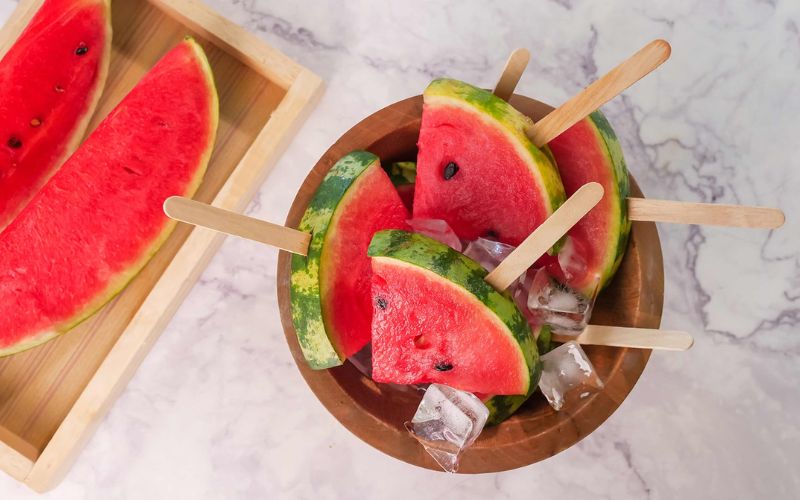
Are you ready to indulge in some juicy watermelon? To ensure a safe and enjoyable slicing experience:
- Thoroughly wash your watermelons outside.
- Once it’s clean and ready, equip yourself with a sharp chef’s knife or cleaver.
- With a steady hand, slice off the bottom of the rind, creating a flat surface that will serve as a sturdy base for the rest of your carving adventure.
Now comes the fun part – deciding how to shape your watermelon slices. You have a variety of options at your disposal. If you’re feeling traditional, go for classic pie-shaped pieces. For a more modern twist, consider cutting the watermelon into neat cubes. And if you’re feeling fancy, grab a melon baller and create perfectly spherical melon balls that are as visually pleasing as delicious.
If you prefer chilled watermelon, don’t hesitate to pop the freshly cut pieces into the fridge for an hour to reach the perfect temperature. This will give you a refreshing and remarkable treat perfect for hot summer days.
After you’ve enjoyed your watermelon feast, preserving any remaining slices for future snacking sessions is crucial. To keep the texture and juiciness intact, tightly wrap all the cut watermelon pieces. You can choose to use an airtight food storage container or opt for the trusty plastic wrap method. If you’re environmentally conscious, eco-friendly alternatives are available to keep your watermelon fresh and ready for your next indulgence.
How to Store Watermelon Juice
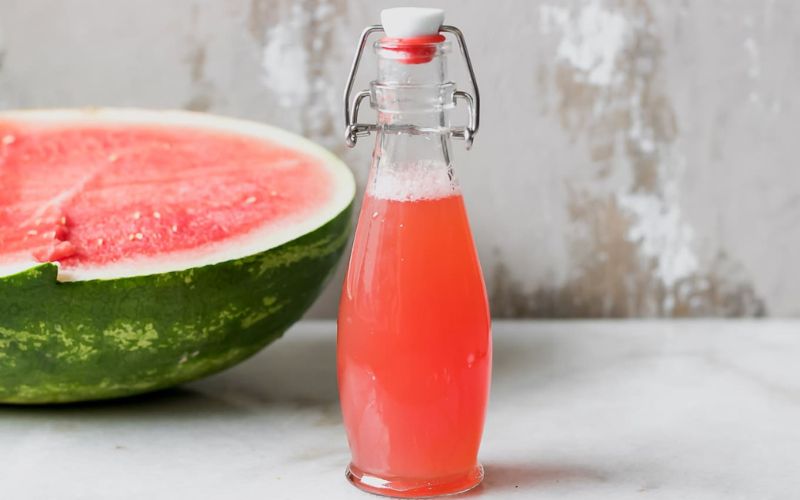
Watermelon juice is absolutely delightful when it is refreshingly cold. To maintain its optimal state, storing this luscious liquid in a cool refrigerator is highly recommended, ensuring that it is securely sealed in a container. Doing so lets you relish its refreshing taste for up to four splendid days.
However, it is worth mentioning that the juice may experience a slight separation due to its natural properties. But fret not! Give it a gentle shake before indulging in every sip, allowing the flavors to harmoniously blend together and deliver an unparalleled quenching experience.
How to Store Watermelon Rind
Before you toss aside the rind that you’ve carefully separated from the juicy flesh of your watermelon, consider taking it a step further and transforming it into a delectable pickled delicacy. Pickled watermelon rind has long been hailed as a beloved condiment in Southern cuisine’s charming and flavorful realm, offering a tempting array of possibilities for culinary creations and delightful snacking experiences.
As you embark on this delightful journey of culinary exploration, you’ll be pleased to discover that the National Watermelon Promotion Board’s esteemed Rind Headquarters is brimming with an abundance of ingenious ideas that will inspire even the most discerning taste buds. Picture this: the humble watermelon rind, elevated to new heights as it takes on various forms, from being roasted to absolute perfection to being gently braised in a medley of enticing flavors.
And if that’s not enough to whet your appetite, imagine transforming it into a luscious gazpacho or delicately shredding it into a savory quiche, adding a unique twist to your culinary repertoire. Remember the sheer versatility of watermelon rind, which effortlessly complements a charcuterie board with its distinct flavor profile and captivating visual appeal.
With its vast potential in sweet and savory dishes, watermelon rind emerges as a true culinary gem, offering endless opportunities to tantalize your taste buds and elevate your gastronomic adventures. And let’s not overlook the fact that you’ve already invested in this remarkable ingredient when you purchased the watermelon itself, making it an unexpected and delightful bonus that won’t cost you an extra penny.
So embrace the remarkable potential of watermelon rind, as it adds a touch of magic and innovation to your culinary endeavors, ensuring that your taste buds are forever grateful for this newfound treasure.
Can You Freeze Watermelon?
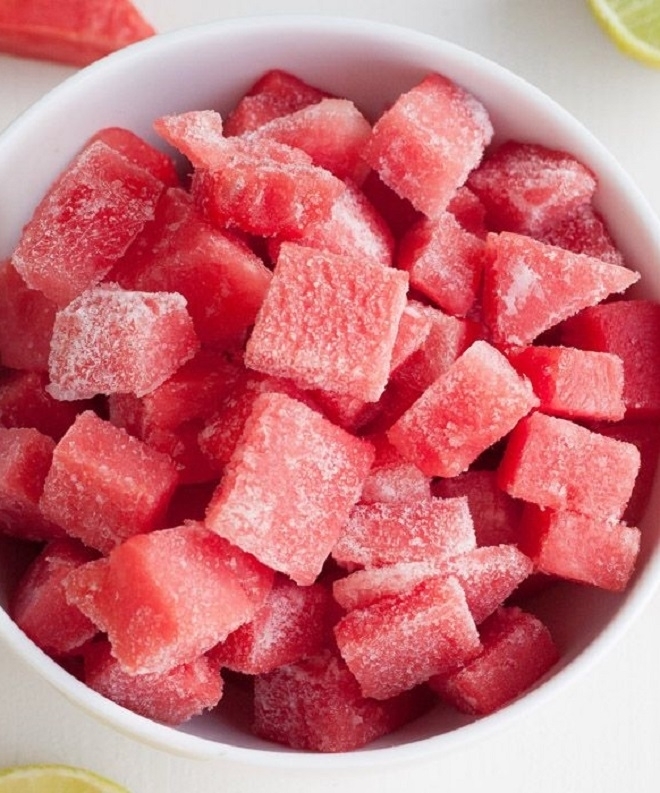
Yes, it is indeed possible to freeze watermelon. However, it is essential to note that freezing the fruit whole is not recommended as it can lead to some less-than-desirable outcomes. For instance, a whole watermelon left in the freezer may become dirty and brutal to slice into unless it is defrosted first. Moreover, depending on the amount of juice in the watermelon, it could burst while frozen in your freezer!
Despite these potential pitfalls, freezing watermelon can result in some delicious culinary creations, all while helping combat food waste. Watermelon can remain fresh in the freezer for approximately a year when properly frozen. To ensure that you freeze your watermelon correctly, follow the simple steps provided below:
- Begin by cutting the watermelon into small and manageable pieces. It is recommended to create either balls or cubes, as these shapes are versatile and can be used in a variety of dishes.
- Next, remove any seeds that may be present in the watermelon pieces. These seeds can be unsightly and affect the texture of your frozen watermelon.
- Take a baking sheet and line it with parchment paper. This will prevent the watermelon pieces from sticking to the tray. Make sure to spread the watermelon pieces on the sheet, ensuring they do not touch one another.
- Place the baking sheet with the watermelon pieces into the freezer for a few hours. This process is known as flash-freezing and will help to ensure that the leftovers freeze quickly and evenly. You will see that they are properly frozen once they become firm to the touch.
- Once the watermelon chunks are fully frozen, transfer them to a container or storage bag that is safe for freezing. Labeling this container or bag with the date is advisable to keep track of how long the frozen watermelon has been stored in your freezer.
Summary of instructions for freezing watermelon
- Keeps up to 8 months
| Step | Instructions |
|---|---|
| Prepare | Remove watermelon rind and cut into cubes. Spread on a sheet pan. |
| Place | Place in the freezer until completely frozen. |
| Transfer | Transfer to Freezer Zipper bags or FreezerWare™ containers. |
| Freeze | Seal, removing excess air (if using bags) then place in deepest part of the freezer. |
Now that you have successfully frozen your watermelon, you can explore a multitude of delicious uses for it. For example, these frozen watermelon pieces can be added to cold summer drinks such as sparkling water, lemonade, or even seasonal cocktails.
If you are feeling adventurous, consider freezing your watermelon in popsicle molds for a refreshing and delightful treat. Additionally, frozen watermelon can be a lovely addition to smoothies or blended cocktails, adding flavor and an excellent texture. The possibilities are endless for incorporating frozen watermelon into your culinary creations!
Should watermelon be kept in the fridge or on the counter?
When it comes to the eternal question of where to store watermelon, the answer is quite simple. Like its melon counterparts, such as cantaloupe and honeydew, watermelon should be kept at room temperature until the moment of truth – when you decide to slice into it and indulge in its juicy goodness.
By allowing the watermelon to bask in the mild warmth of your kitchen counter, you ensure it retains its optimal flavor and sweetness. However, once you’ve committed the act of slicing, it is time to shift gears and transfer the remaining portions to the cool embrace of the refrigerator.
This will help to extend its lifespan and preserve its splendid taste for as long as possible. Remember, though, that watermelon’s refrigerated shelf life should be at most four days, so endeavor to enjoy its refreshing essence within this timeframe.
How do you keep watermelon fresh after cutting it?
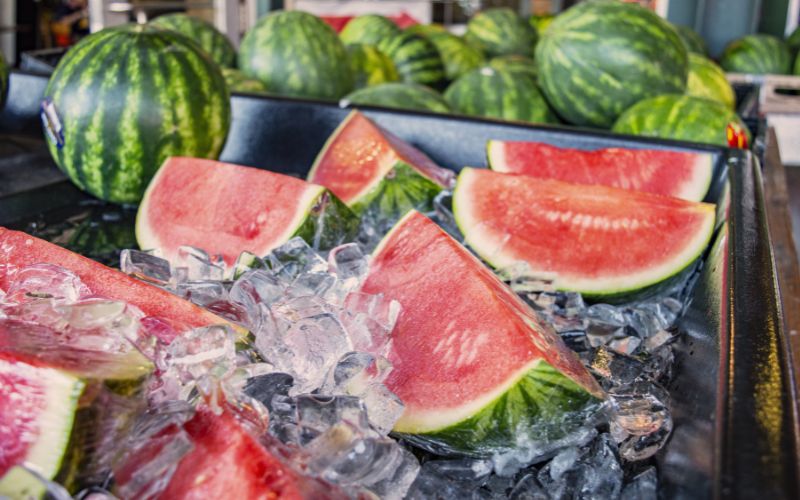
Following a few simple steps is essential to keep your watermelon fresh and delicious after it has been cut. First and foremost, make sure to store the cut watermelon in the refrigerator. This will help maintain its freshness and prevent it from spoiling too quickly.
Secondly, tightly wrap the exposed cut side of the watermelon with cling film. This will create a protective barrier and help seal in its juicy goodness. Replacing the cling film each time you re-wrap your watermelon is recommended, as this will ensure maximum freshness.
Lastly, if you have any leftover pieces of melon, store them in an airtight container before placing them in the fridge. This will help preserve their flavor and texture, allowing you to enjoy them for extended periods. By following these easy steps, you can savor the sweetness of your watermelon even after it has been cut.
How long can you keep watermelon in the fridge?
A whole, unsliced watermelon can be kept in the refrigerator for approximately 3-4 weeks. However, once the watermelon is cut, its shelf life significantly decreases. To ensure optimal quality and prevent any risk of food poisoning, storing watermelon chunks in the refrigerator and consuming them within 3-5 days of cutting is recommended. This will help maintain their freshness and flavor for a more extended period.
How do you store watermelon for months?
To store watermelon for an extended period of time, the first step is to carefully remove the rind. Once that’s done, it’s time to cut juicy melon convenient. After that, the secret lies in the watermelon pieces in a single layer on a baking sheet until they are delightful.
To maximize freshness and avoid unwanted freezer burn, transferring the frozen water into an airtight container or trust zip-top freezer bag is crucial. With this method, you can keep your frozen watermelon treasure stored for up to six months, ready to be enjoyed when the craving strikes.
Can watermelon last a week in the fridge?
Watermelons, those delightful summer treats, possess varying lifespans depending on their state and storage conditions. Whole watermelons can maintain their freshness when stored at room temperature for about a week.
However, if you decide to place them in the chilly confines of the refrigerator, they can endure for up to two weeks. Now, when it comes to cutting watermelon, the story changes slightly. Once sliced and refrigerated, this juicy fruit will remain palatable for 3 to 5 days, providing ample time to savor its sweet goodness.
How long does uncut watermelon last?
The shelf life of an uncut watermelon is influenced by various factors, such as storage conditions and ripeness at the time of purchase. When stored at room temperature in a cool and dry place, an uncut watermelon can typically maintain its freshness for about 7 to 10 days.
It is essential to keep it away from direct sunlight as exposure to heat can accelerate the spoilage process. If you wish to further prolong its lifespan, refrigeration is highly recommended. Placing the whole watermelon in the refrigerator can extend its freshness for up to 2 weeks.
This storage method helps preserve the watermelon’s taste, texture, and juiciness, allowing you to enjoy its refreshing flavor for extended periods. So whether you plan to savor it as a refreshing snack or use it as an ingredient in various recipes, knowing how to properly store an uncut watermelon can significantly enhance its longevity and ensure that it remains perfectly delicious when you’re ready to indulge in its juicy goodness.
How is watermelon best stored?
When storing watermelon, there are a few key steps to remember. Firstly, it’s essential to let the whole watermelon sit at room temperature until it reaches the peak of ripeness. This allows the flavors to fully develop and ensures a deliciously juicy fruit.
Once the watermelon is perfectly ripe, it’s time to transfer it to the refrigerator. Placing the whole watermelon, without any covering, in the fridge can help prolong its freshness and prevent it from becoming overripe too quickly.
Let’s say you’ve already cut into the watermelon and have some leftover slices or halves. To keep them as fresh as possible, sealing them in a Glad® Zipper Bag is recommended. This will help maintain their juiciness and prevent any unwanted moisture loss.
How do you wash and store watermelon?
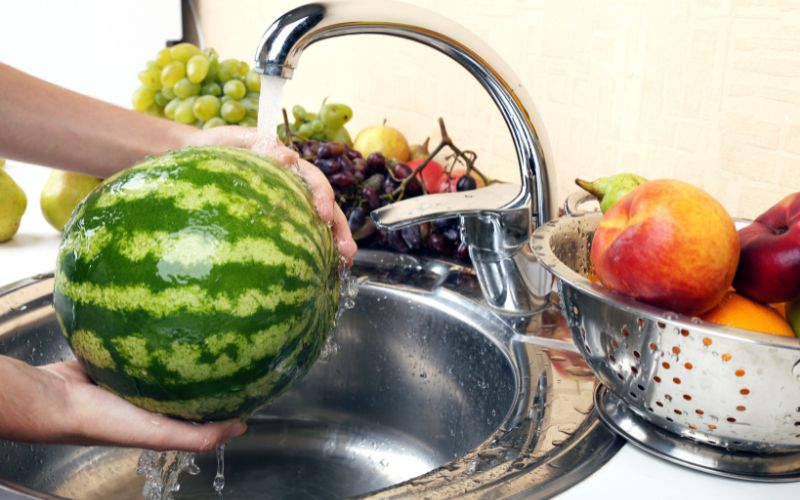
When washing and storing watermelon, remember a few key steps. First and foremost, giving the watermelon a thorough wash is essential to ensure that any dirt or pathogens on the rind are removed. This not only helps to maintain its freshness but also promotes food safety.
To wash your uncut watermelon, you have a few options. One popular method is to use a tub or deep sink filled with cool water. You can effectively remove any surface dirt or debris by submerging the watermelon and gently scrubbing the rind with your hands or a soft brush. Alternatively, if you don’t have access to a tub or deep sink, you can use a cooler filled with water to accomplish the same task.
After giving the watermelon a good wash, it’s essential to let it dry before storing it. You can either air dry it by leaving it out on a clean towel or countertop or pat it dry with a clean paper towel. This step helps prevent any moisture from being trapped against the rind, potentially leading to mold or spoilage.
Once the watermelon is dry, it’s time to store it properly. Please keep it in a cool and dry place like a pantry or cellar. It’s important to avoid storing it in direct sunlight or areas with high humidity, as this can accelerate the ripening process and potentially cause the watermelon to spoil faster.
How do you preserve watermelon without a refrigerator?
If you plan to cut up your melon later, storing the whole watermelon at room temperature, out of direct sunlight, is best. This will help preserve its freshness and prevent it from becoming overripe too quickly.
Keeping the watermelon at room temperature allows it to ripen naturally and develop its full flavor. However, it’s essential to remember that you should still cut up your watermelon or freeze it within two weeks of buying the whole fruit.
This will ensure that you can enjoy it more and make the most out of your purchase. So, next time you find yourself without a refrigerator to store your watermelon, remember to keep it at room temperature for optimal preservation.
Can I store watermelon in a Tupperware?
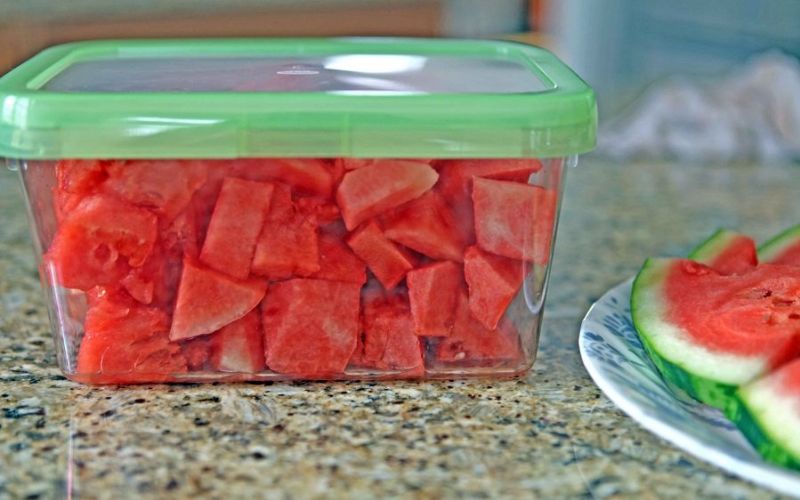
Yes, you can definitely store watermelon in a Tupperware container. The tight seal of the Tupperware will effectively prevent any excess juices from leaking out and making a mess. In fact, if you have taken the time to cut your watermelon into convenient cubes, you can easily store them in an airtight Tupperware container in the refrigerator.
This way, you can keep your watermelon fresh and ready to enjoy whenever possible. Of course, there are other options than Tupperware – any other food storage containers will work just as well for storing your watermelon cubes. So, use whatever containers you have to keep your watermelon fresh and delicious for extended periods.
How long does watermelon stay good in plastic bags in the fridge?
When refrigerated in plastic bags, watermelon can stay fresh for 3 to 5 days. This storage method helps extend the fruit’s shelf life, ensuring that you can enjoy it for a more extended period.
It is vital to ensure the watermelon is correctly sealed in the bags and kept in the fridge to maintain its freshness. These simple steps ensure that your watermelon stays excellent and ready to be enjoyed whenever you indulge in its juicy goodness.

